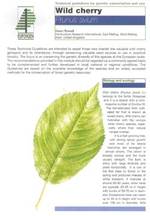Prunus avium - Technical guidelines for genetic conservation and use for wild cherry
This publication has been translated into the following languages:
Slovenian Italian
The objective of genetic conservation is to ensure the continued survival and adaptability of the species. Where sufficiently large populations are available, in situ conservation efforts should focus on identifying core populations of more than 20 distinct individuals. The natural regeneration of cherry trees should be a management priority. To avoid inbreeding depression, these core populations should ideally be linked by establishing new plantings using trees from other sources such as seed orchards or breeding populations with similar ecological conditions. Trees occurring at the extreme margins of the distribution range should also be conserved. However, as cherry grows in very scattered populations with relatively few individuals, the most effective conservation strategies are likely to be ex situ seed orchards and clonal banks.
Ex situ grafted clonal seed orchards should consist of at least 30 different genotypes from the same ecogeographic region. These should be established in locations favourable for growth and seed production, and should be well protected from vermin, and isolated from sweet cherry and other cherry species to avoid hybridization. Ten or so replicates per clone should be propagated onto healthy rootstocks. The use of dwarf rootstocks enables more intensive plantings of about 3 m rows with 5 m gaps, and also encourages precocious seed production. Other rootstocks will require wider spacing of 5 m x 5 m or more and may require thinning in later years. The seed orchard should be designed to ensure that a good mixture of clones is achieved. However, if the incompatibility alleles are known for each clone, they can be arranged to avoid planting incompatible genotypes next to each other. During the establishment years, full control of weeds, pests and diseases should be undertaken and pruning carried out to encourage a broad, open crown for fruiting. Seed should be collected throughout the orchard and supplied as a mixture to nurseries and growers. Regional seed orchards can form the basis of a Multiple Population Breeding System. Ideally, in MPBS, breeding population is subdivided into subpopulations which are then grown over a wide range of site conditions. Each subpopulation may have the same or different breeding goal.
Clonal banks should be established where the long-term future of the planting is secure. They should include a very broad range of genotypes, both geographically and genetically, e.g. superior timber trees with breeding potential as well as trees with conservation value and other species. Ideally, the accessions should be virus free, well documented and clearly labelled. A minimum of two replicates per clone should be planted. The rootstock used determines the spacing required, and the planting should ideally have a full management programme of weed, pest and disease control. Where possible, it should also be duplicated on another site. If trees die, they should be removed and replaced. The content of a clonal bank should be reviewed after several years and repropagated if necessary to ensure a healthy collection is maintained.
Provenance, progeny and clonal trials and demonstration plantings can also have potential conservation value. Encouraging the utilisation of wild cherry could also be important in promoting its planting and management.
Authors: Karen Russell
Corporate Author: European Forest Genetic Resources Programme
Journal/Series: EUFORGEN Technical Guidelines for Genetic Conservation and Use
Publication Year: 2003
Publication Format: Folder; PDF
ISBN: 92-9043-572-0
ISBN 13: 978-92-9043-572-3
Language: EN
Pages: 6 p.

